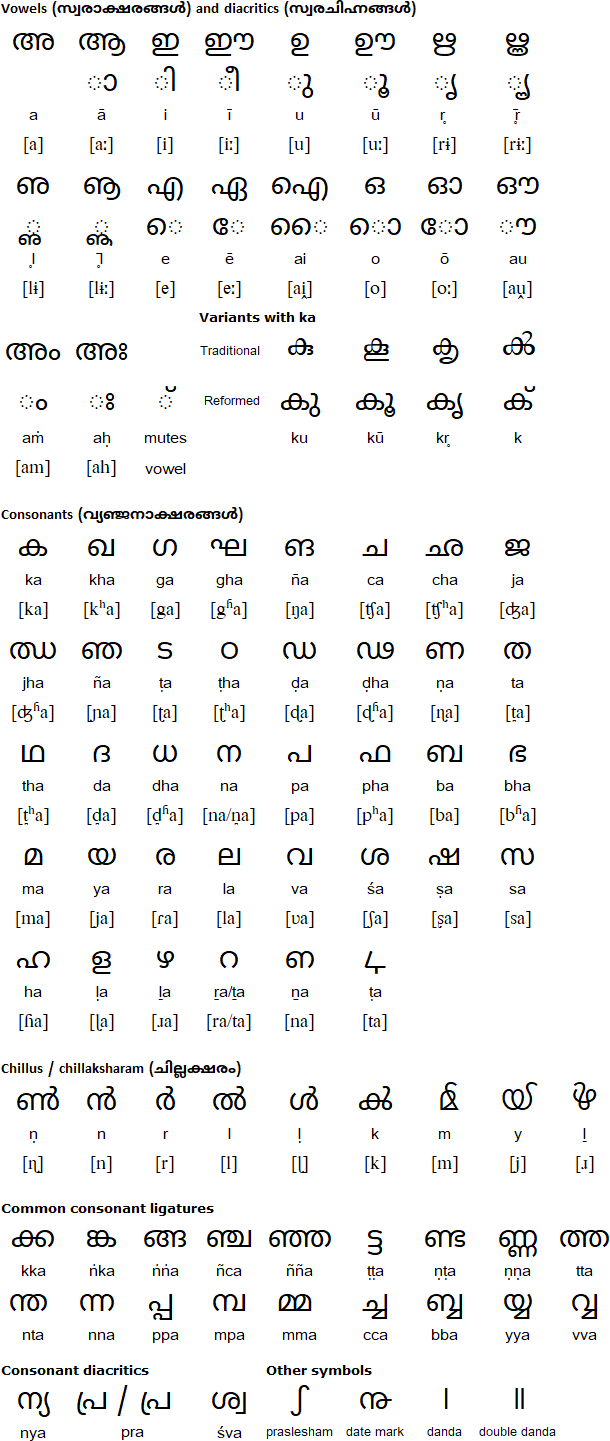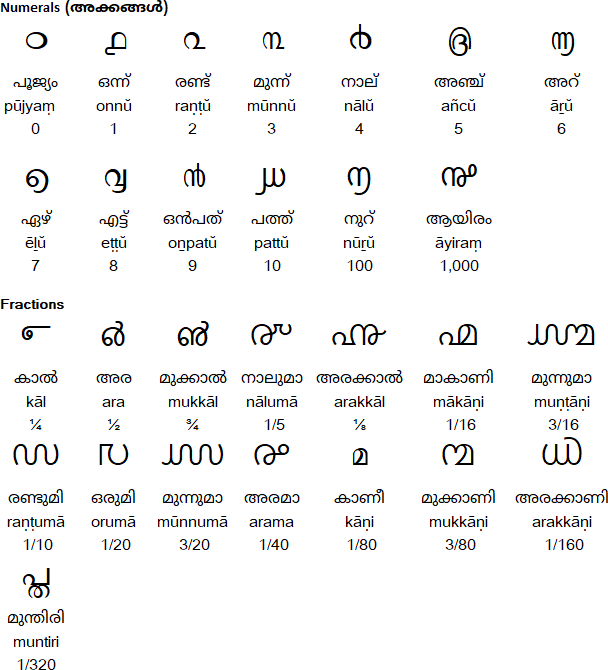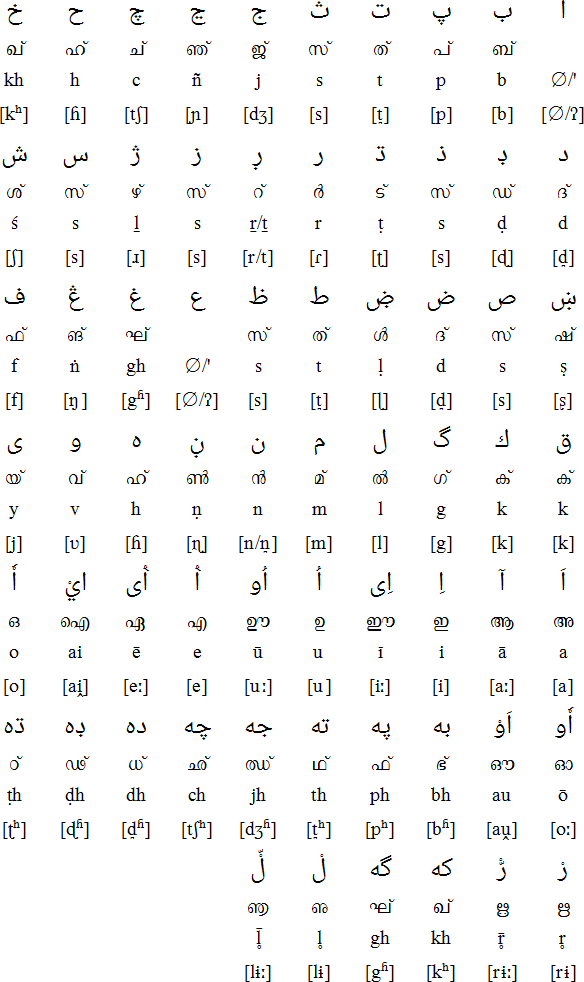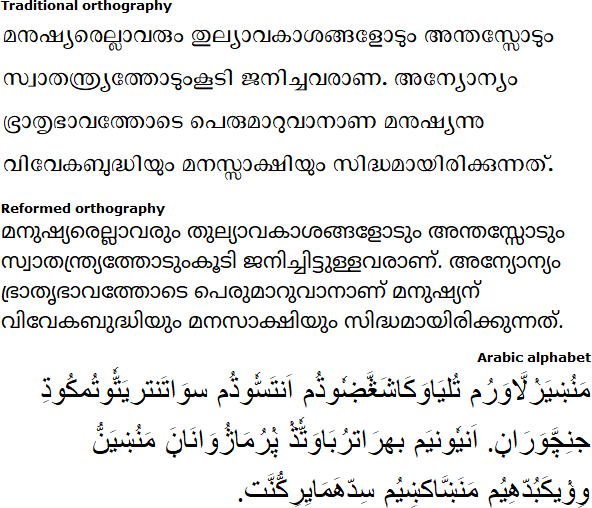Malayalam alphabet, pronunciation and language (original) (raw)
Malayalam is a Southern Dravidian language spoken mainly in the state of Kerala in southern India, and also in Tamil Nadu, Karnataka, Maharashtra, Lakshadweep, Puducherry and the Andaman and Nicobar Islands. In 2011 there were about 35.5 million speakers of Malayalam in India.
There are speakers of Malayalam in a number of other countries, including: UAE (1 million), Sri Lanka (732,000), Malaysia (344,000), Oman (212,000), USA (146,000), Qatar (71,600) and Australia (53,200).
Malayalam at a glance
Native name: മലയാളം (malayāḷam) [mʌlʌjaːɭʌm])
Language family: Dravidian, Southern Dravidian, Tamil-Kannada, Tamil-Kodagu, Tamil-Malayalam
Number of speakers: c. 38 million
Spoken in: India,
First written: 4th century AD
Writing system: Malayalam and Arabic scripts (current), Grantha, Vatteluttu and several other scripts (past)
Status: statutory provincial language in Kerala, Lakshadweep and Mahé, Puducherry in India
Malayalam is also known as Alealum, Malayalani, Malayali, Malean, Maliyad, Mallealle or Mopla. The name Malayalam means "mountain region", and comes from mala (mountain) and alam (region). Original the name referred to the land of the Chera dynasty (2nd century BC - 3rd century AD), which corresponds to modern Kerala and Tamil Nadu, and was later used to refer to the language.
[top]
Written Malayalam
Malayalam was first written with the Vatteluttu alphabet (വട്ടെഴുത്ത് Vaṭṭeḻuttŭ), which means 'round writing' and developed from the Brahmi script. The oldest known writing in Malayalam is known as the Edakal-5 inscription, is in the Vatteluttu alphabet, and dates from late 4th century or the early 5th century AD [more details].
A version of the Grantha alphabet originally used in the Chola kingdom was brought to the southwest of India in the 8th or 9th century and was adapted to write the Malayalam and Tulu languages. By the early 13th century it is thought that a systemised Malayalam alphabet had emerged. Some changes were made to the alphabet over the following centuries, and by the middle of the 19th century the Malayalam alphabet had attained its current form.
As a result of the difficulties of printing Malayalam, a simplified or reformed version of the script was introduced during the 1970s and 1980s. The main change involved writing consonants and diacritics separately rather than as complex characters. These changes are not applied consistently so the modern script is often a mixture of traditional and simplified letters.
Malayalam is also regularly written with a version of the Arabic script by Muslims in Singapore and Malaysia, and occasionally by Muslims in Kerala. Christians in Kerala used to write Malayalam with the Syriac script and use a variety of Malayalam known as Suriyani Malayalam in their liturgy.
Notable features
- Type of writing system: Abugida / Syllabic Alphabet in which all consonants have an inherent vowel. Diacritics, which can appear above, below, before or after a consonant, are used to change the inherent vowel.
- When they appear at the beginning of a syllable, vowels are written as independent letters.
- When certain consonants occur together, special conjunct symbols are used which combine the essential parts of each letter.
- Writing direction: left to right in horizontal lines.
- Used to write: Kodava,Konkani, Malayalam,Ravula
[top]
Malayalam alphabet (മലയാളലിപി)

Notes
- When combined with vowel diacritics some consonants change shape. This doesn't happen in the reformed version of the script (in red on the right)
- The vowels ഋ (r̥), ൠ (r̥̄), ഌ (l̥) and ൡ (l̥̄) are used in Sanskrit words. They are called semi-vowels and are phonetically closer to vowels in Malayalam and Classical Sanskrit. The letters and signs for ൠ (r̥̄), ഌ (l̥) and ൡ (l̥̄) are very rare and are not considered as part of the modern orthography.
- ഫ [pʰ] is occasionally pronounced [f] in loanwords.
- A chillu or chillaksharam represents pure consonants independently, without help of a virama (്). Unlike a consonant represented by an ordinary consonant letter, these consonants are never followed by an inherent vowel.
- The consonant ഩ (ṉa) is archaic and represents an apical alveolar nasal, as opposed to the laminal dental nasal represented by ന (na). In the current orthography,m both are written as ന (na).
- The consonant ഺ (ṯa) is archaic and represents the voiceless unaspirated apical alveolar plosive, as opposed to the voiceless dental plosive represented by ത (ta). In the current orthography this sound is written with a റ below another റ ⟨റ്റ⟩ (ṟṟa) or sometimes next to each other ⟨ററ⟩ (ṟṟa).
- The Ccillus ൿ (k), ൔ (m), ൕ (y) and ൖ (ḻ) are obsolete and not used in the modern orthography.
- The ligatures for ച (ca), ബ (ba), യ (ya), and വ (va) are special in that a doubled consonant is denoted by a triangle sign below the consonant letter.
Learn how to pronounce Malayalam letters:

[top]
Arabic script for Malayalam

ق ,غ ,ع ,ظ ,ط ,ض ,ص ,ز ,ذ ,خ ,ح are only used in Arabic loanwords.
Download alphabet charts for Malayalam (Excel)
Some information provided by Michael Peter Füstumum
[top]
Sample text

Transliteration
man̠uṣyarellāvaruṁ tulyāvakāśaṅṅaḷōṭuṁ antassōṭuṁ svātantryattōṭuṅkūṭi jan̠icciṭṭuḷḷavarāṇŭ. an̠yōn̠yaṁ bhrātr̥bhāvattōṭe perumāṟuvān̠āṇŭ man̠uṣyan̠ŭ vivēkabuddhiyuṁ man̠asākṣiyuṁ siddhamāyirikkunnatŭ.
A recording of this text by Vijay Prabhu
Translation
All human beings are born free and equal in dignity and rights. They are endowed with reason and conscience and should act towards one another in a spirit of brotherhood.
(Article 1 of the Universal Declaration of Human Rights)
[top]
Sample videos in Malayalam
Information about Malayalam | Suriyani Malayalam | Phrases | Numbers | Tower of Babel | Learning materials
[top]
Links
Information Malayalam
http://en.wikipedia.org/wiki/Malayalam
http://www.cs.cmu.edu/afs/cs/usr/vipin/www/mal.html
http://www.malayalamresourcecentre.org
Online Malayalam lessons
http://www.learn-malayalam.com
http://websitefor.info/learn/malayalam/
http://www.entemalayalam.org
http://www.kpmalayalam.com
http://malayalamteacher.com
http://polymath.org/malayalam.php
Malayalam phrases
http://www.jaimalayalam.com/vegam_vegam_malayalam.htm
http://www.languageshome.com/English-Malayalam.htm
Online Malayalam dictionaries
http://www.prokerala.com/general/dictionary/
http://www.mashithantu.com/dictionary/
http://www.dictionary.tamilcube.com/malayalam-dictionary.aspx
http://malayalam.changathi.com/Dictionary.aspx
http://dsal.uchicago.edu/dictionaries/gundert/
http://www.shabdkosh.com/ml/
http://olam.in
Malayalam fonts
http://www.wazu.jp/gallery/Fonts_Malayalam.html
http://www.prokerala.com/downloads/fonts.php
https://sites.google.com/site/fontpacksite/malayalam-fonts
https://sites.google.com/site/cibu/
http://www.horomatching.com/KattaFont.aspx
https://smc.org.in/fonts/
The Bible in Malayalam (Unicode)
http://216.156.35.218/Default.asp
Online Malayalam news
http://www.mathrubhumi.com
http://www.malayalamanorama.com
http://tvnew.in/
https://www.vachakam.com/
Online Malayalam transliterator
http://www.writeka.com
Dravidian languages
Badaga, Brahui,Dhundari,Gondi,Irula,Jatapu,Kannada,Kodava,Kolam,Konda,Koya,Kurukh, Malayalam,Malto,Mukha Dora,Ravula,Sankethi,Savara,Sunuwar, Suriyani Malayalam,Tamil,Telugu,Toda,Tulu, Yerukula
Languages written with the Malayalam alphabet
Kodava,Konkani, Malayalam,Ravula
Abugidas / Syllabic alphabets
Ahom,Aima,Arleng,Badagu,Badlit,Basahan,Balinese,Balti-A,Balti-B,Batak,Baybayin,Bengali,Bhaiksuki,Bhujimol,Bilang-bilang,Bima,Blackfoot,Brahmi,Buhid,Burmese,Carrier,Chakma,Cham,Cree,Dehong Dai,Devanagari,Dham Lipi,Dhankari / Sirmauri,Ditema,Dives Akuru,Dogra,Ethiopic,Evēla Akuru,Fox,Fraser,Gond,Goykanadi,Grantha,Gujarati,Gunjala Gondi,Gupta,Gurmukhi,Halbi Lipi,Hanifi,Hanuno'o,Hočąk,Ibalnan,Incung,Inuktitut,Jaunsari Takri,Javanese,Kaithi,Kadamba,Kamarupi,Kannada,Kawi,Kharosthi,Khema,Khe Prih,Khmer,Khojki,Khudabadi,Kirat Rai,Kōchi,Komering,Kulitan,Kurukh Banna,Lampung,Lanna,Lao,Lepcha,Limbu,Lontara/Makasar,Lota Ende,Magar Akkha,Mahajani,Malayalam,Meitei (Modern),Manpuri (Old),Marchen,Meetei Yelhou Mayek,Meroïtic,Masarm Gondi,Modi,Mon,Mongolian Horizontal Square Script,Multani,Nandinagari,Newa,New Tai Lue,Ojibwe,Odia,Ogan,Pahawh Hmong,Pallava,Phags-pa,Purva Licchavi,Qiang / Rma,Ranjana,Rejang (Kaganga),Sasak,Savara,Satera Jontal,Shan,Sharda,Sheek Bakrii Saphaloo,Siddham,Sinhala,Sorang Sompeng,Sourashtra,Soyombo,Sukhothai,Sundanese,Syloti Nagri,Tagbanwa,Takri,Tamil,Tanchangya (Ka-Pat),Tani,Thaana,Telugu,Thai,Tibetan,Tigalari,Tikamuli,Tocharian,Tolong Siki,Vatteluttu,Warang Citi
[top]
You can support this site by Buying Me A Coffee, and if you like what you see on this page, you can use the buttons below to share it with people you know.
If you like this site and find it useful, you can support it by making a donation via PayPal or Patreon, or by contributing in other ways. Omniglot is how I make my living.
Note: all links on this site to Amazon.com


[top]


